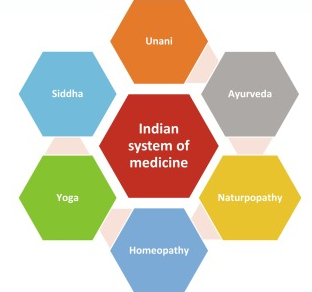Governance
Global Centre for Traditional Medicine: Gujarat
- 19 Apr 2022
- 7 min read
For Prelims: GCTM, WHO, Traditional Medicine, Artificial intelligence
For Mains: Global Centre for Traditional Medicine (GCTM) and its significance, Traditional Medicine
Why in News?
Recently, the groundbreaking ceremony was performed for the first-of-its-kind World Health Organization (WHO) Global Centre for Traditional Medicine (GCTM) in Jamnagar, Gujarat.
- Additionally, the Global Ayush Investment and Innovation Summit will be held later this month in Gandhinagar which is aimed at increasing investments and showcase innovations in the field of traditional medicine.
- It is a unique attempt to foster long-lasting partnerships, boost exports and nurture a sustainable ecosystem.
What is the Purpose for establishing GCTM?
- Integrating with Technological Advancements:
- The Centre aims to channel the potential of traditional medicine, by integrating it with technological advancements and evidence-based research.
- Set Policies and Standards:
- It will seek to set policies and standards on traditional medicine products and help countries create a comprehensive, safe, and high-quality health system.
- Support Efforts to Implement WHO Strategy:
- It will support efforts to implement the WHO’s Traditional Medicine Strategy (2014-23).
- It aims to support nations in developing policies & action plans to strengthen the role of traditional medicine in pursuing the goal of universal health coverage.
- According to WHO estimates, 80% of the world’s population uses traditional medicine.
- India has committed an estimated USD 250 million to support the GCTM’s establishment, infrastructure and operations.
- It will support efforts to implement the WHO’s Traditional Medicine Strategy (2014-23).
- Focus on four main strategic areas:
- Evidence and learning
- Data and analytics
- Sustainability and equity and
- Innovation and technology to optimise the contribution of traditional medicine to global health.
What is Traditional Medicine?
- About:
- According to the WHO, traditional medicine is the total sum of the “knowledge, skills and practises indigenous and different cultures have used over time to maintain health and prevent, diagnose and treat physical and mental illness”.
- Its reach encompasses ancient practices such as acupuncture, ayurvedic medicine and herbal mixtures as well as modern medicines.
- Traditional Medicine in India:
- In India, it is often defined as including practices and therapies — such as yoga, Ayurveda, Siddha.
- These therapies and practices have been part of Indian tradition historically as well as others — such as homoeopathy — that became part of Indian tradition over the years.
- Ayurveda and yoga are practised widely across the country.
- The Siddha system is followed predominantly in Tamil Nadu and Kerala
- The Sowa-Rigpa system is practised mainly in Leh-Ladakh and Himalayan regions such as Sikkim, Arunachal Pradesh, Darjeeling, Lahaul & Spiti.
- In India, it is often defined as including practices and therapies — such as yoga, Ayurveda, Siddha.
What is the Need to Advance Knowledge of Traditional Medicine?
- Traditional Medicine Workers not integrated:
- National health systems and strategies do not yet fully integrate traditional medicine workers, accredited courses and health facilities.
- Conserving Biodiversity:
- There is a need to conserve biodiversity and sustainability as about 40% of approved pharmaceutical products today derive from natural substances.
- For Example: The discovery of aspirin drew on traditional medicine formulations using the bark of the willow tree, the contraceptive pill was developed from the roots of wild yam plants and child cancer treatments have been based on the rosy periwinkle.
- There is a need to conserve biodiversity and sustainability as about 40% of approved pharmaceutical products today derive from natural substances.
- Modernisation in Studying Traditional Medicine:
- The WHO has referred to modernisation of the ways traditional medicine is being studied.
- Artificial intelligence is now used to map evidence and trends in traditional medicine.
- Functional magnetic resonance imaging is used to study brain activity and the relaxation response that is part of some traditional medicine therapies such as meditation and yoga, which are increasingly drawn on for mental health and well-being in stressful times.
- The WHO has referred to modernisation of the ways traditional medicine is being studied.
- Serve as a Hub for Other Countries:
- Traditional medicine is also being extensively updated by mobile phone apps, online classes, and other technologies.
- The GCTM will serve as a hub for other countries, and build standards on traditional medicine practices and products.
What are the Similar Collaborative Efforts taken by India Earlier?
- Project Collaboration Agreement (PCA) :
- In 2016, the Ministry of AYUSH signed a Project Collaboration Agreement (PCA) with the WHO in the area of traditional medicine.
- The aim was to create benchmarks for training in yoga, Ayurveda, Unani and Panchakarma, for traditional medicine practitioners.
- The collaboration also aimed at promoting the quality and safety of traditional medicine and consumer protection by supporting WHO in the development and implementation of the WHO Traditional and Complementary Medicine Strategy.
- In 2016, the Ministry of AYUSH signed a Project Collaboration Agreement (PCA) with the WHO in the area of traditional medicine.
- Related MoUs Signed:
- At least 32 MoUs for undertaking collaborative research and development of traditional medicine have been signed with institutes, universities and organisations from the US, Germany, UK, Canada, Malaysia, Brazil, Australia, Austria, Tajikistan, Saudi Arabia, Ecuador, Japan, Indonesia, Reunion Island, Korea and Hungary.
- Also, the Council of Scientific and Industrial Research (CSIR) and the Bill & Melinda Gates Foundation have signed an MoU to identify opportunities for scientific and technological research between researchers within and outside India, including collaborations with foundation-funded entities in the areas including traditional medicine as well as beyond.







